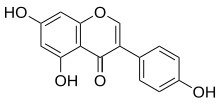|
تضامنًا مع حق الشعب الفلسطيني |
جينيسيتن
| جينيسيتن | |
|---|---|
| الاسم النظامي (IUPAC) | |
5,7-Dihydroxy-3-(4-hydroxyphenyl)chromen-4-one |
|
| أسماء أخرى | |
4',5,7-Trihydroxyisoflavone |
|
| المعرفات | |
| رقم CAS | 446-72-0 |
| بوب كيم (PubChem) | 5280961 |
مواصفات الإدخال النصي المبسط للجزيئات
|
|
|
|
| الخواص | |
| صيغة كيميائية | C15H10O5 |
| كتلة مولية | 270.24 غ.مول−1 |
| في حال عدم ورود غير ذلك فإن البيانات الواردة أعلاه معطاة بالحالة القياسية (عند 25 °س و 100 كيلوباسكال) | |
| تعديل مصدري - تعديل | |
الجينيسيتن (بالإنجليزية: Genistein) هو الاستروجين النباتي، وينتمي إلى فئة من الايسوفلافون.(Isoflavones) تم عزل الجينيستين أولا في عام 1899 من مكنسة الصباغ.، جينيستا صبغية. وبالتالي، فإن الاسم الكيميائي. تم تأسيس هيكله في عام 1926، وصنع كيميائيا في عام 1928.[1]
تواجده
تم العثور على الجينيستين في عدد من النباتات بما في ذلك الترمس، الفول، فول الصويا.[2][3]
الوظيفة
يقوم الجينيستين بوظئف عديدة ومهمة في الطرق البيوكيميائية وايضاً في وظائف في الخلايا الحية:ومن تلك الوظائف : تنشيط مستقبلات تنشيط ناشر بيروكسية (PPARs).تثبيط عدة تحركات التيروزية.تثبيط topoisomerase .تثبيط AAAD تحفيز الالتهام الذاتي .[4][5][6] تثبيط الثدييات هيكسوز نقل GLUT1. تقلص عدة أنواع من العضلات الملساء.التشكيل من قناة CFTR، بالتالي يؤدي إلى افتتاحه في انخفاض التركيز وتثبيط عليه الجرعات الكبيرة. تثبيط السيتوزين . تثبيط ناقلة ميثيل الحمض النووي .تثبيط مستقبلات الجلايسين.[7]
- inhibition of the glycine receptor
المراجع
- ^ Walter، E. D. (1941). "Genistin (an Isoflavone Glucoside) and its Aglucone, Genistein, from Soybeans". Journal of the American Chemical Society. ج. 63 ع. 12: 3273–76. DOI:10.1021/ja01857a013.
- ^ Coward، Lori؛ Barnes، Neil C.؛ Setchell، Kenneth D. R.؛ Barnes، Stephen (1993). "Genistein, daidzein, and their β-glycoside conjugates: Antitumor isoflavones in soybean foods from American and Asian diets". Journal of Agricultural and Food Chemistry. ج. 41 ع. 11: 1961–7. DOI:10.1021/jf00035a027.
- ^ Kaufman، Peter B.؛ Duke، James A.؛ Brielmann، Harry؛ Boik، John؛ Hoyt، James E. (1997). "A Comparative Survey of Leguminous Plants as Sources of the Isoflavones, Genistein and Daidzein: Implications for Human Nutrition and Health". The Journal of Alternative and Complementary Medicine. ج. 3 ع. 1: 7–12. DOI:10.1089/acm.1997.3.7. PMID:9395689.
- ^ Gossner، G؛ Choi، M؛ Tan، L؛ Fogoros، S؛ Griffith، K؛ Kuenker، M؛ Liu، J (2007). "Genistein-induced apoptosis and autophagocytosis in ovarian cancer cells". Gynecologic Oncology. ج. 105 ع. 1: 23–30. DOI:10.1016/j.ygyno.2006.11.009. PMID:17234261.
- ^ Singletary، K.؛ Milner، J. (2008). "Diet, Autophagy, and Cancer: A Review". Cancer Epidemiology Biomarkers & Prevention. ج. 17 ع. 7: 1596–610. DOI:10.1158/1055-9965.EPI-07-2917. PMID:18628411.
- ^ Nakamura، Yoshitaka؛ Yogosawa، Shingo؛ Izutani، Yasuyuki؛ Watanabe، Hirotsuna؛ Otsuji، Eigo؛ Sakai، Tosiyuki (2009). "A combination of indol-3-carbinol and genistein synergistically induces apoptosis in human colon cancer HT-29 cells by inhibiting Akt phosphorylation and progression of autophagy". Molecular Cancer. ج. 8: 100. DOI:10.1186/1476-4598-8-100. PMC:2784428. PMID:19909554.
- ^ Fang، Mingzhu؛ Chen، Dapeng؛ Yang، Chung S. (يناير 2007). "Dietary polyphenols may affect DNA methylation". The Journal of Nutrition. ج. 137 ع. 1 Suppl: 223S–228S. PMID:17182830. مؤرشف من الأصل في 2020-02-22.
وصلات لإضافية
- Compound Summary at NCBI PubChem
- Fact Sheet at Zerobreastcancer
- Information at Phytochemicals
- Chemical Compound Review at Wikigenes
- Information at Chemicalbook
- Description at SpringerReference
- Description at NCI Drug Dictionary
قالب:Phytoestrogens قالب:Isoflavone
قالب:Glycinergics قالب:Adrenergics قالب:Estrogenics قالب:Nuclear receptor ligands قالب:Steroid hormone metabolism modulators
| في كومنز صور وملفات عن: جينيسيتن |

